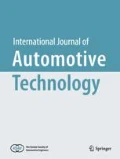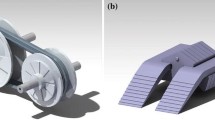Abstract
The objective of this research is geometrical and kinematical optimization of full-toroidal continuously variable transmission (CVT) in order to achieve high power transmission efficiency and low mass. At first, a dynamic analysis is performed for the system. A computer model is developed to simulate elastohydrodynamic (EHL) contact between disks and roller and consequently, calculate CVT efficiency. The validity of EHL model is investigated by comparing output of this model and experimental data. Geometrical parameters are obtained by means of Particle Swarm Optimization algorithm, while the optimization objective is to maximize CVT efficiency and minimize its mass. The algorithm is run for different values of selected input parameters that are oil temperature, roller tilting angle (speed ratio). Optimization results show that optimized geometrical parameters are approximately constant for various values of input parameters. Also, it is observed that, increasing values of oil temperature and roller tilting angle (in clockwise direction), will decrease power transmission efficiency. An average power transmission efficiency of 86.7% is achieved over a wide range of input parameters, using optimized geometry.
Similar content being viewed by others
References
Attia, N. A., Datong, Q. I. N., Wankai, S. and Huaying, L. I. (2003). A parametric study on the contact stress of half toroidal continuously variable transmission. J. Chongqing University 2,2, 6–11.
Birch, S. (2000). Audi takes CVT from 15th century to 21st century. Automotive Engineering Int., 68–71.
Carbone, G., Mangialardi, L. and Mantriota, G. (2001). Fuel Consumption of a Mid Class Vehicle with Infinitely Variable Transmission. SAE. Warrendale.
Carbone, G., Mangialardi, L. and Mantriota, G. (2004). A comparison of the performances of full and half toroidal traction drives. Mechanism and Machine Theory 39,9, 921–942.
Delkhosh, M., Saadat Foumani, M., Boroushaki, M., Ekhtiari, M. and Dehghani, M. (2011). Geometrical optimization of half toroidal CVT using particle swarm optimization. Scientia Iranica 18,5, 1126–1132.
Dowson, D., Taylor, C. M. and Godet, M. (1991). Vehicle tribology. Proc. 17th Leeds-Lyon Symp. Tribology Held at the Institute of Tribology, Leeds University, Leeds, UK, 4th–7th September 1990, Elsevier Science Ltd., 18.
Imanishi, T. and Machida, H. (2001). Development of powertoros unit half-toroidal CVT (2). Motion & Control, NSK Technical J., 10, 1–8.
Jacod, B., Venner, C. H. and Lugt, P. M. (2001). A generalized traction curve for EHL contacts. J. Tribology, 123, 248.
Machida, M. and Murakami, Y. (2000). Development of the half toroidal CVT powertors unit. NSK Tech. J. 9,669, 15–26.
Nanbu, T., Yasuda, Y., Ushijima, K., Watanabe, J. and Zhu, D. (2008). Increase of traction coefficient due to surface microtexture. Tribology Letters 29,2, 105–118.
Newall, J. and Lee, A. (2003). Measurement and prediction of spin losses in the EHL point contacts of the full toroidal variator. Tribology and Interface Engineering Series, 43, 769–779.
Park, N. G., Ryu, J. H., Lee, H. W., Jeon, Y. H. and Zhang, N. (2009). Development of the inner spherical CVT for a motorcycle. Int. J. Automotive Technology 10,3, 341–346.
Poon, S. Y. and Haines, D. J. (1966). Frictional behaviour of lubricated rolling-contact elements. ARCHIVE, Proc. Institution of Mechanical Engineers 1847–1982 (vols 1–196), 181,1966, 363–389.
Rousseau, A., Saglini, S., Jaklov, M., Gray, D. and Hardy, K. (2003). Trade-offs betweem fuel economy and Nox emssions using fuzzy logic control with a hybrid CVT configuration. Int. J. Automotive Technology 4,1, 47–55.
Ryu, W. and Kim, H. (2008). CVT ratio control with consideration of CVT system loss. Int. J. Automotive Technology 9,4, 459–465.
Sanda, S. and Hayakawa, K. (2005). Traction drive system and its characteristics as power transmission. R&D Review of Toyota CRDL 40,3, 30–39.
Srivastava, N. and Haque, I. (2009). Nonlinear dynamics of a friction-limited drive: Application to a chain continuously variable transmission (CVT) system. J. Sound and Vibration 321,1–2, 319–341.
Statnikov, R. B. (1999). Multicriteria Design: Optimization and Identification. Springer. Netherlands.
Suh, B., Frank, A., Chung, Y. J., Lee, E. Y., Chang, Y. H. and Han, S. B. (2011). Powertrain system optimization for a heavy-duty hybrid electric bus. Int. J. Automotive Technology 12,1, 131–139.
Szeri, A. Z. (2010). Fluid Film Lubrication. Cambridge University Press.
Tanaka, H. and Machida, H. (1996). Half-toroidal traction drive continuously variable power transmission. ARCHIVE: Proc. Institution of Mechanical Engineers, Part J: J. Engineering Tribology 1994–1996 (vols 208–210) 210,310, 205–212.
Yasutomi, S., Bair, S. and Winer, W. O. (1984). An application of a free volume model to lubricant rheology I-dependence of viscosity on temperature and pressure. J. Tribology, 106, 291–302.
Zheng, C. H., Lim, W. S. and Cha, S. W. (2011). Performance optimization of CVT for two-wheeled vehicles. Int. J. Automotive Technology 12,3, 461–468.
Zhu, C., Liu, H., Tian, J., Xiao, Q. and Du, X. (2010). Experimental investigation on the efficiency of the pulley-drive CVT. Int. J. Automotive Technology 11,2, 257–261.
Author information
Authors and Affiliations
Corresponding author
Rights and permissions
About this article
Cite this article
Delkhosh, M., Saadat Foumani, M. Multi-objective geometrical optimization of full toroidal CVT. Int.J Automot. Technol. 14, 707–715 (2013). https://doi.org/10.1007/s12239-013-0077-0
Received:
Revised:
Accepted:
Published:
Issue Date:
DOI: https://doi.org/10.1007/s12239-013-0077-0




